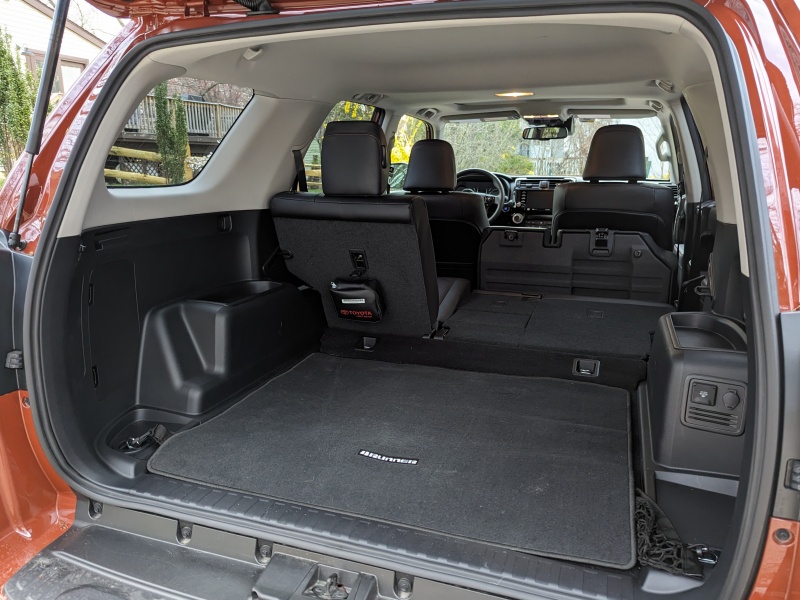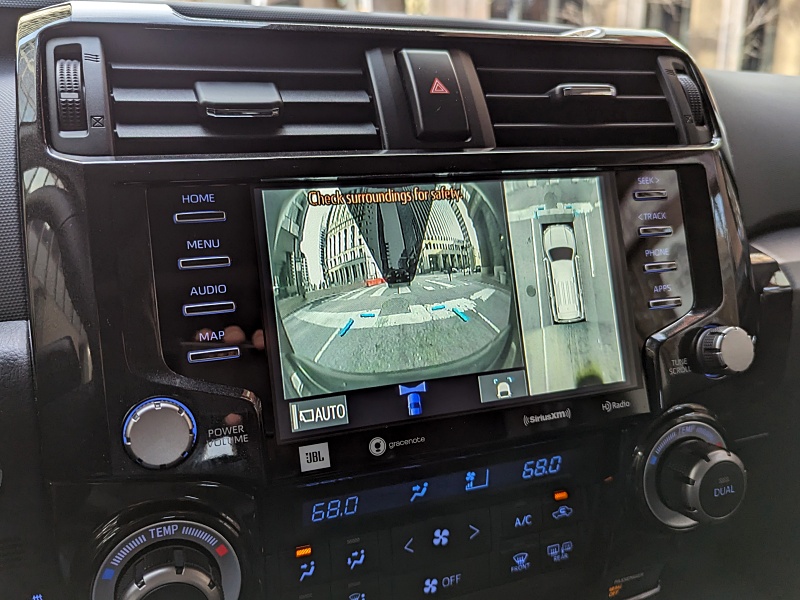Recent Articles
Popular Makes
Body Types
2024 Toyota 4Runner Road Test and Review

2024 Toyota 4Runner TRD Pro ・ Photo by Brady Holt
For the first time in 15 years, Toyota is about to redesign the 4Runner mid-size SUV. The 4Runner is an unlikely success story. By rejecting the norms of how a modern SUV should look, feel, and drive, the off-road-ready 4Runner gained sales momentum in its golden years rather than losing it.
The 2025 4Runner arrives this coming fall as a ground-up new model with a new platform, a choice of new turbocharged four-cylinder engines, and a big new touchscreen. In the meantime, we just tested the 2024 Toyota 4Runner for a reminder about what we’ll be saying goodbye to. Is this a relic that’s finally being put out to pasture – or a gem that you should grab before it’s gone? Keep reading as we go through the pros and cons of this unique SUV package to see what the right answer is for you.
What It Costs
One ticket to the 4Runner’s success is its variety. Toyota sells the 4Runner in the comfort-focused SR5 ($40,705), SR5 Premium ($43,765), and Limited ($49,940) trim levels; the on-road-focused TRD Sport ($43,565); and the off-road-focused TRD Off Road ($44,550), TRD Off Road Premium ($47,130), and TRD Pro ($55,170). Four-wheel-drive costs about $1,900 extra on all but the off-road models, where it’s standard. A destination charge adds $1,395 to all models.
These aren’t low-budget prices. Still, many light-duty mid-size crossovers like Toyota’s own Highlander have gotten nearly as expensive – and without the 4Runner’s mighty hardware. When the current 4Runner debuted in 2010, it cost $31,000 versus the Highlander’s $26,000; now, they’re only about $1,500 apart. What’s more, the 4Runner has proven itself to have exceptional resale value. And like other Toyotas, it includes two years or 25,000 miles of free scheduled maintenance.

2024 Toyota 4Runner TRD Pro ・ Photo by Brady Holt
Enduring Design
Toyota has sold 1.4 million 4Runners since the last time it made any major changes to the model, including more than 100,000 per year annually since 2016. So you’d think the novelty would wear off. It hasn’t. Whenever we test 4Runners, we’ll hear about them from neighbors and acquaintances who don’t bat an eye at brand-new just-released models.
The vertical front of the vehicle looks like a battering ram with headlights, especially on our TRD Pro test vehicle. The bumper curves up and away from under the vehicle to provide more off-road clearance, and protective skid plates are visible underneath. The fenders are squared-off and flared, and the vehicle’s body is a chunky box. Different 4Runner models offer different grille designs: Luxury-themed versions break up the big grille into three pieces, while off-road models have a bigger lower area that’s protected. And the TRD Pro replaces the oval Toyota logo with purposeful lettering. Think hard about the TRD Pro's big cargo rack, though; it’s too tall for some garages. Our test vehicle also wears a newly introduced coat of Terra Orange paint.

2024 Toyota 4Runner TRD Pro ・ Photo by Brady Holt
Simple Interior
The 4Runner’s interior hasn’t changed much since 2010, either – for better or for worse. Devotees love the old-school analog vibe with big buttons and knobs, a chunky dashboard, and a small 8-inch touchscreen that’s built into the instrument panel. Still, it’s not all archaic. The touchscreen, introduced in 2020, is usefully laid out. And it supports Android Auto and Apple CarPlay smartphone integration.
The 2025 4Runner’s interior looks promising to us, though. Shared with the latest Toyota Tacoma pickup, it’s still chunky and purposeful, and it still has plenty of buttons and knobs. It doubles down on a rugged vibe, and it dumps the current 4Runner’s shiny piano-black dashboard trim. There’s a big new 14-inch touchscreen on the 2025 model's upper trim levels, but a simple 8-inch unit remains available as well for folks who want to minimize their digital life. We don’t see many people pining for the old 4Runner’s dashboard, as the new one preserves the best of its character while also supporting a more luxurious, high-tech experience for those who want it.

2024 Toyota 4Runner TRD Pro ・ Photo by Brady Holt
Ample Space
Truck-based SUVs like the Toyota 4Runner typically have less interior room than similarly sized front-wheel-drive crossovers. But the boxy 4Runner acquits itself admirably. In fact, compared with the slightly longer and wider Toyota Highlander, the 4Runner actually has more total cargo capacity – thanks to its boxier styling and higher roof.
You get an outstanding 47.2 cubic feet of cargo space behind its second-row seat and 89.7 cubic feet behind the front seats. An optional slide-out cargo tray makes it easy to load and unload items weighing up to 440 pounds or can serve as a seat, and the 4Runner is the only current vehicle with a power-retractable rear windshield. The front and second-row seats are also comfortable, with generous space for five passengers. The main issue is if you’re counting on the optional third-row seat. It’s not available on any of the 4Runner’s off-road-focused trim levels (which represent most of the model lineup). This seat is also cramped, and it leaves just 9 cubic feet of cargo space when it’s in use. Some buyers will also miss a power liftgate, but Toyota does provide a dangling strap for short-statured drivers.

2024 Toyota 4Runner TRD Pro ・ Photo by Brady Holt
Off-Road-Ready Suspension
More and more crossover SUVs are available with off-road-themed trim levels. But the 4Runner is the real deal. With 9.6 inches of ground clearance, a departure angle of 26 degrees, and an approach angle of 33 degrees, this is an SUV that will carry you up, over, and through whatever you throw at it. You can also equip it with four-wheel drive with a two-speed transfer case, a locking rear differential, selectable off-road driving modes, an adjustable “Crawl Control” feature that maintains your speed automatically as you negotiate obstacles, and a system that can automatically disconnect the suspension sway bars to let the wheels rise up and down more on uneven surfaces. Our tested TRD Pro model has Fox high-performance shocks, retuned springs, an even thicker front skid plate, and all-terrain tires.
Surprisingly, even the TRD Pro doesn’t ride poorly. Its forgiving suspension bounces over bumps with an appealing blend of heavy-duty character and everyday comfort. But even the on-road-focused TRD Sport, with a revised suspension, won’t handle with the agility of a car-based SUV. You’ll slow down to take a turn.

2024 Toyota 4Runner TRD Pro ・ Photo by Brady Holt
Aging Powertrain
The 4Runner shows its age most under the hood, where its ancient 4.0-liter V6 and five-speed automatic transmission are both a blessing and a curse.
On the one hand, this powertrain has proven reliability. Most of the time, we hedge a car’s reputation for reliability with the caveat that it’ll take 10 years to see how well it’ll really hold up. The 4Runner has already demonstrated its longevity. On the other hand, its EPA-estimated 16 mpg in the city, 19 mpg on the highway, and 17 mpg combined means a 2024 4Runner will burn through a lot of gasoline over a 400,000-mile lifespan. The engine also makes a lot of noise before it’s willing to get moving, and it’s never speedy even under full throttle. Toyota hasn’t yet proven how long the four-cylinder turbo engines in the next-generation 4Runner (one of them a gas-electric hybrid) will last. But at worst, they’ll likely be more satisfying to drive while saving money on fuel.

2024 Toyota 4Runner TRD Pro ・ Photo by Brady Holt
Mixed Safety Record
The 4Runner also shows its age in its mediocre crash-test performance. That’s another point that will surely improve in next year’s redesign – an important point for families buying this Toyota SUV. Its structure wasn’t strong enough to withstand the Insurance Institute for Highway Safety’s small-overlap frontal crash test, earning the second-lowest score of Marginal. The IIHS hasn’t even subjected the 4Runner to its newest, toughest tests, and it earned a middling four out of five stars from the National Highway Traffic Safety Administration as well.
On the flip side, Toyota did retrofit the old 4Runner with advanced safety technologies over the years. Standard features include adaptive cruise control, blind-spot monitoring with a rear cross-traffic alert, automatic emergency braking, and a lane-departure warning. The surround-view camera system shown here, handy whether you’re tackling a trail or tackling a tight parking spot, is also available on most trim levels.

2024 Toyota 4Runner TRD Pro ・ Photo by Brady Holt
Varied Alternatives
When you’re looking for a genuinely tough mid-size SUV, the 4Runner has just a handful of rivals. The best-selling Jeep Wrangler and the Ford Bronco offer open-air motoring with removable roofs and doors. The Bronco also drives well on road, and both are more economical than the 4Runner. However, the 4Runner is roomier and, especially prior to its redesign, has an unshakable reputation for reliability. Another mid-size Jeep, the Grand Cherokee, is also a 4Runner rival. It’s capable, yet with an attitude of sumptuous luxury and advanced technology rather than rough-and-tumble muscle. It’s smoother, quieter, and swankier than the 4Runner, but not as roomy or as bursting with character.
Meanwhile, if you aren’t in love with the 4Runner’s vibe and just need to tackle bumpy conditions on your way to an outdoor adventure, the Subaru Outback crossover is entirely more sensible: affordable, economical, comfortable, and safe. Sensible isn’t exactly charming or fun, though, while the 4Runner – for all its logical drawbacks – can be exactly that. And if you’re just looking for a large family car, other crossover favorites include the Kia Telluride, Mazda CX-90, and hybrid versions of the Toyota Highlander and Grand Highlander. However, you'll likely give back some of your fuel savings in resale value. The 4Runner is a likely future classic, especially in its final year of the old generation.

2023 Jeep Grand Cherokee 4xe ・ Photo by Brady Holt
Looking to the Future
Of course, the biggest competitor to a 2024 Toyota 4Runner is a 2025 Toyota 4Runner. If you buy one today, you’re choosing it over the new model that’s just a few months away from dealers. A tried-and-true vehicle will likely have fewer bugs than a ground-up redesign, both in the short term and the long term. And the 4Runner already blends capability, comfort, and everyday utility. Still, the next-generation model seems poised to retain the model’s familiar character while improving on objective points like power, efficiency, handling, safety, and interior quality.
One more option, arriving even sooner than the new 4Runner, is the reintroduced 2024 Toyota Land Cruiser. It’s hitting dealers as we write in April 2024 as a mid-size SUV (rather than the full-size model it used to be). In fact, it will share many mechanical components – including its four-cylinder hybrid engine – with the next-generation 4Runner. And its starting price is about the same as a top-of-the-line 4Runner like our test vehicle. It’s a way to get the 4Runner experience with a different style and yet another iconic off-road nameplate.

2024 Toyota 4Runner TRD Pro ・ Photo by Brady Holt